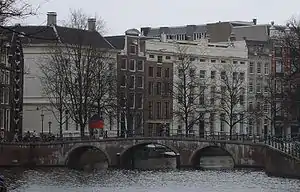Thomas Hope (banker, born 1704)
Thomas Hope (1704, Rotterdam – 26 December 1779, Amsterdam) was a Dutch banker and administrator of the VOC.
Family

The Hope family originally came from Scotland. Archibald Hope, the father of Thomas, was a Quaker who had eight sons. Archibald – along with his eldest son Archibald Jr. – played a principal part in trade in Rotterdam around 1720. His second eldest son Henry (later father of Henry Hope) went to seek riches in the United States. Younger sons Isaac and Zacharias remained in Rotterdam, where, as ship-owners, they organized the 1735 transatlantic crossing by the Swiss Mennonite emigrants to Pennsylvania. Archibald and second youngest brother Thomas moved to Amsterdam.
Life
After the economic bubble of 1720, Thomas' older brother Archibald founded the trade and banking house Hope & Co, when he tried his luck by opening a branch of his fathers banking house Hopes in Amsterdam. In those early years he simply lodged with a cousin and spent his days at the Amsterdam exchange. He was clearly successful, because Thomas joined him and was given power of attorney in 1724. When Archibald married they opened an office in 1726, and the next year Thomas married the daughter of a well-to-do Amsterdam merchant, Margaretha Marcelis. When Archibald died in 1734, Thomas was joined by his youngest brother Adrian. The business became successful in trade with England, America and the slave trade with the West Indies. The stadholders William IV and William V (1766) appointed Thomas Hope as their representative with the VOC and the WIC.
Thomas Hope came up with a system of cost calculation. Thomas Hope is considered as a possible author of the Proposition: a proposal at the Parliament of the Netherlands in 1751 to improve Holland's diminishing trade position through abolition of the export tax and lowering import tax. The proposal did not take up considerable time on the agenda, but was enacted by other countries.

The Hope brothers' business affairs (like those of many others) flourished for many reasons, including loans for the war between England and France (1756–1763). In 1758, Thomas bought Mattheus Lestevenon's (then Dutch ambassador in France) attractive building at Keizersgracht 444-446. In 1759, the Hope business had 26 co-workers. The next-door house at 448 was bought in 1763 for Henry Hope, the nephew from America. Thomas had one son, Jan Hope, who was about the same age as Henry, and they had been traveling companions on their grand tour. Together they would continue to build the Hopes name internationally. In 1763 many Amsterdam businesses went bust when the Brothers De Neufville could not pay their creditors, resulting in an international financial crisis (Isaac de Pinto, for example, got into difficulties and had to give up his house), but Hope & Co. continued to flourish through international loans and share dealing.
Other residents of Keizersgracht 444
- Mattheus Lestevenon
- Thomas's widow Margaretha Marcelis and his son Jan Hope
- Thomas's grandson Thomas Hope
- Adriaan van der Hoop